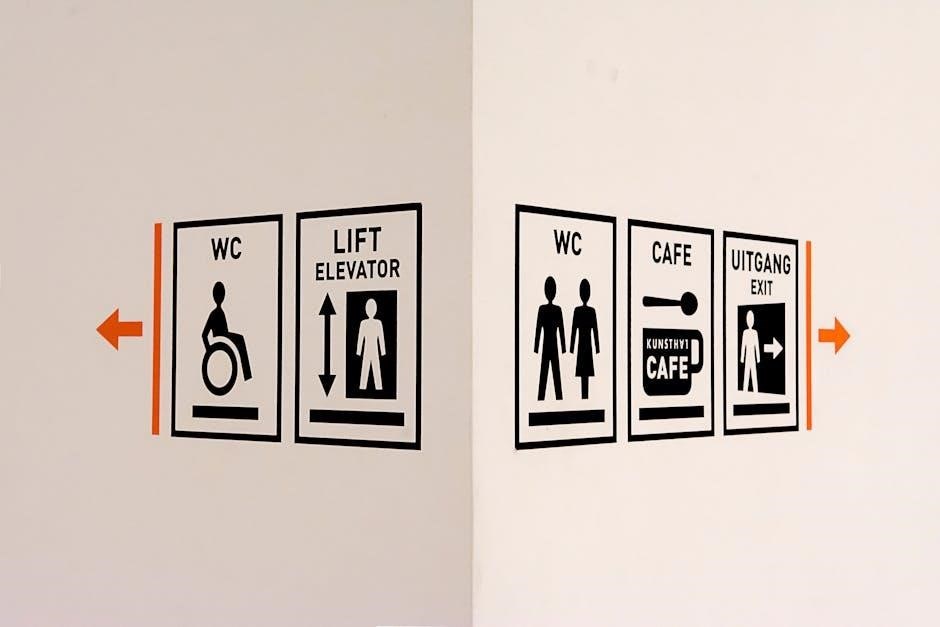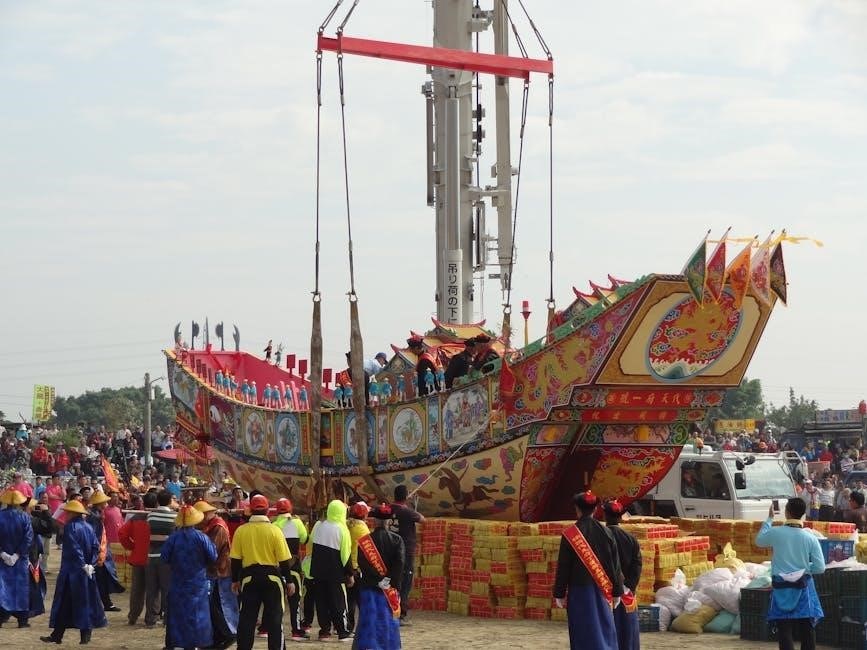Rotary lift installation requires precision and adherence to safety standards to ensure efficiency and reliability in automotive maintenance and repair operations. This guide provides a comprehensive overview of the installation process‚ highlighting key steps‚ safety precautions‚ and best practices to achieve a successful setup. Proper installation is crucial for optimal performance and longevity of the lift‚ ensuring a safe working environment for technicians and operators alike. By following the detailed instructions and recommendations outlined in this manual‚ users can confidently complete the installation process‚ meeting both industry standards and personal safety requirements. The information provided is designed to assist both professionals and DIY enthusiasts in understanding the complexities of rotary lift installation‚ enabling them to achieve a secure and functional setup.
Overview of Rotary Lifts
Rotary lifts are essential equipment in automotive repair shops‚ designed to elevate vehicles for maintenance‚ repairs‚ and inspections. Available in various models like two-post‚ four-post‚ and scissor lifts‚ they offer versatility and durability. These lifts are engineered to handle heavy loads safely‚ ensuring optimal performance and longevity. Two-post lifts are popular for their space efficiency and ease of use‚ while four-post lifts provide higher weight capacity and stability. Scissor lifts are ideal for low-clearance vehicles and specific maintenance tasks. Each type is tailored to different garage needs‚ emphasizing the importance of selecting the right lift based on the vehicle types serviced and available space. Understanding their design and functionality is crucial for proper installation and operation.
Importance of Proper Installation
Proper installation of a rotary lift is critical to ensure safety‚ functionality‚ and longevity. Improper installation can lead to structural compromise‚ posing risks to operators and vehicles. Adhering to manufacturer guidelines guarantees that the lift operates as intended‚ minimizing hazards and ensuring reliable performance. A well-installed lift also prevents potential damage to the equipment and the vehicles it supports. Additionally‚ correct installation ensures compliance with industry safety standards‚ protecting both personnel and assets. Neglecting proper installation procedures can result in costly repairs‚ downtime‚ and even legal liabilities. Therefore‚ meticulous attention to installation details is essential to maintain a safe and efficient working environment in any automotive repair setting.

Safety Precautions
Always wear personal protective equipment‚ ensure the area is clear of obstacles‚ and follow the manufacturer’s guidelines to minimize risks during installation and operation.
Pre-Installation Safety Checks
Before starting the installation‚ conduct a thorough inspection of the site to ensure it is free from hazards. Check the floor for levelness and stability‚ as any unevenness can compromise the lift’s performance and safety. Verify that all tools and equipment are in good working condition and that the area is well-ventilated. Review the installation manual to familiarize yourself with specific safety recommendations. Ensure that all personnel involved in the installation are properly trained and aware of potential risks. Additionally‚ check the weather conditions if installing outdoors‚ as adverse weather can hinder the process and pose additional safety risks. Electrical connections should also be inspected to prevent any short circuits or malfunctions during the installation process. By addressing these factors beforehand‚ you can significantly reduce the likelihood of accidents and ensure a smooth installation experience. Proper preparation is key to a safe and successful setup.
Common Hazards During Installation
During the installation of a rotary lift‚ several hazards can arise if proper precautions are not taken. One of the most critical risks is improper anchoring‚ which can lead to lift instability and potential collapse. Additionally‚ electrical connections pose a significant hazard if not handled correctly‚ as they can result in shocks or fires. Overloading the lift during testing is another common mistake‚ which can cause structural failure. Environmental factors‚ such as uneven flooring or exposure to moisture‚ can also compromise the lift’s stability and safety. Furthermore‚ improper use of tools or equipment can lead to accidents‚ emphasizing the need for trained personnel. Addressing these hazards proactively is essential to ensure a safe and successful installation process.

Tools and Equipment Required
The installation process demands essential tools like wrenches‚ sockets‚ and hydraulic pumps. Specialized equipment‚ such as a concrete drill and anchor bolts‚ ensures a secure setup. Proper tools guarantee safety and efficiency during the process.
Essential Tools for Installation
Installing a rotary lift requires a set of essential tools to ensure accuracy and safety. These include wrenches‚ sockets‚ and torque wrenches for securing bolts and nuts. A hydraulic pump is necessary for operating the lift’s cylinders. Additionally‚ screwdrivers‚ pliers‚ and Allen keys are needed for adjusting components. A level tool ensures the lift is properly aligned. Anchoring equipment‚ such as concrete drills and anchor bolts‚ is critical for securing the lift to the floor. Safety gear‚ including gloves and safety glasses‚ should always be worn. Having these tools readily available streamlines the installation process and prevents delays. Proper tool organization also minimizes the risk of losing parts or damaging components during assembly.
Specialized Equipment Needed
Specialized equipment is crucial for a successful rotary lift installation. Hydraulic pressure pumps and high-capacity jacks are essential for lifting and aligning the lift’s heavy components. A laser level ensures precise alignment‚ preventing uneven installation. Customized anchor kits‚ designed for the lift’s specific model‚ are necessary for securing it to the floor. Additionally‚ a torque multiplier may be required for tightening bolts to the recommended specifications. Some installations may also need a pneumatic drill for concrete anchor placement. Always refer to the manufacturer’s guidelines for any model-specific tools. Having the right specialized equipment ensures a safe and efficient installation process‚ avoiding potential damage to the lift or surrounding structures. Proper equipment usage also guarantees compliance with safety standards and optimal performance of the lift.

Site Preparation
Ensure the installation area is clear‚ with adequate space for the lift and tools. Verify the floor is level‚ stable‚ and meets weight requirements for safe operation.
Space Requirements for Installation
Adequate space is essential for installing a rotary lift to ensure safe and efficient operation. The area must accommodate the lift’s dimensions‚ with additional clearance for tools and personnel. Ensure at least 12 inches of clearance on all sides of the lift to allow easy access. For overhead models‚ verify ceiling height matches the lift’s maximum rise. A clear‚ unobstructed working area prevents accidents and ensures proper alignment during installation. Measure the space carefully to avoid last-minute adjustments. Always refer to the manufacturer’s specifications for exact dimensions and clearance requirements. Proper spacing ensures the lift functions safely and efficiently‚ adhering to industry standards and installation guidelines. A well-planned layout minimizes risks and ensures smooth operation.
Ensuring a Level and Stable Surface
A level and stable surface is critical for proper rotary lift installation and operation. Begin by inspecting the floor to ensure it is even and free from cracks or unevenness. Use a laser level or spirit level to verify the surface is perfectly horizontal. If necessary‚ apply shims or self-leveling concrete to achieve the required flatness. The surface must also be strong enough to support the combined weight of the lift and the vehicles it will hold. Check the manufacturer’s specifications for minimum floor thickness and weight-bearing requirements. A stable base ensures the lift operates smoothly‚ prevents structural damage‚ and minimizes the risk of accidents. Always test the surface’s stability before proceeding with the installation to guarantee safety and functionality.

Assembly of Rotary Lift Components
Begin by carefully unpacking and organizing all components according to the installation manual. Follow the step-by-step instructions to assemble each part‚ ensuring proper alignment and secure connections; This process is crucial for the lift’s stability and functionality‚ so attention to detail is essential at every stage.
Unpacking and Organizing Parts
Begin by carefully unpacking all components from the packaging‚ ensuring no parts are damaged or missing. Refer to the installation manual for a detailed inventory list. Organize the parts logically‚ grouping similar items together to streamline the assembly process. Label or categorize components to avoid confusion later. Place smaller parts‚ such as bolts and hardware‚ in labeled containers for easy access. Position larger components‚ like lift columns and arms‚ near the installation site to save time during assembly. Double-check each part against the manual to confirm completeness and inspect for any visible damage. Proper organization is key to a smooth and efficient installation process‚ reducing delays and potential errors. This step ensures all elements are accounted for before proceeding.
Step-by-Step Assembly Process
Start by assembling the main lift columns‚ ensuring they are securely attached to the base plates. Follow the manual’s instructions to connect the lift arms‚ making sure they are properly aligned and tightened. Next‚ install the hydraulic cylinders and hoses‚ carefully routing them to avoid kinking or damage. Attach the safety locks and latches‚ ensuring they engage smoothly. Connect the electrical components‚ such as the motor and control panel‚ adhering to the wiring diagram provided. Use torque wrenches to tighten all bolts to the specified torque values. Double-check all connections and alignments before proceeding to the installation phase. Proper assembly is critical for the lift’s functionality and safety‚ so take your time and follow each step meticulously. This process ensures a sturdy and reliable setup for years of service.

Installation Process
The installation process involves carefully aligning and securing the lift components to the prepared site‚ ensuring all safety and manufacturer guidelines are strictly followed for optimal performance.
Foundation Work and Anchoring
Proper foundation work and anchoring are critical for the stability and safety of a rotary lift. Begin by ensuring the concrete slab is at least 4-6 inches thick and reinforced with steel rebar to support the lift’s weight. Anchor bolts must be embedded in the concrete according to the manufacturer’s specifications‚ typically spaced evenly around the lift’s baseplate. Once the concrete is cured‚ align the lift’s baseplate precisely with the anchor bolts and secure it using high-strength nuts and washers. Tighten the bolts in a star pattern to ensure even pressure distribution. Double-check the alignment and leveling of the lift to prevent uneven stress on the foundation. Finally‚ torque the bolts to the recommended specification to complete the anchoring process securely.
Electrical and Hydraulic Connections
Connect the rotary lift to a dedicated 220V power supply‚ ensuring the circuit is equipped with a 30-amp breaker for optimal performance. Install the electrical components according to the manufacturer’s wiring diagram‚ and ensure all connections are secure and properly insulated. For hydraulic systems‚ attach the high-pressure hoses to the power unit and lift cylinders‚ tightening all fittings firmly. Use a hydraulic fluid recommended by the manufacturer and fill the reservoir to the specified level. Inspect all connections for leaks and test the system under low pressure before full operation. Always follow the installation manual for specific voltage and fluid requirements to ensure safe and efficient functionality of the lift.

Testing the Lift
Conduct initial tests of lift controls and safety features. Perform load testing to ensure stability. Verify all safety mechanisms function correctly to meet industry standards.
Initial Testing and Calibration
Initial testing and calibration are critical to ensure the lift operates safely and efficiently. Begin with a visual inspection of all components and connections. Test the lift controls to confirm smooth operation. Check safety features like emergency stops and lock mechanisms. Calibrate the lift according to the manufacturer’s specifications‚ ensuring accurate height adjustments. Perform a load test with the recommended weight to verify stability and functionality. Refer to the installation manual for specific calibration procedures. Document the results and address any issues promptly. Proper calibration ensures optimal performance and adheres to safety standards‚ providing peace of mind for future use.

Load Testing and Safety Verification
Load testing and safety verification are essential to confirm the lift’s reliability and adherence to safety standards. Begin by conducting a visual inspection of all components‚ ensuring no damage or misalignment. Gradually apply the maximum rated load‚ observing the lift’s stability and smooth operation. Test all safety features‚ including emergency stops‚ lock mechanisms‚ and overload protection. Verify that the lift holds the load securely at various heights. Check for any unusual noises or movements that may indicate issues. Document the test results and address any concerns before releasing the lift for regular use. This step ensures the lift operates safely and efficiently‚ protecting both personnel and equipment.

Maintenance and Upkeep
Regular lubrication of moving parts‚ inspection of bolts‚ and annual professional servicing ensure optimal performance and longevity of the rotary lift‚ maintaining safety and reliability over time.
Regular Maintenance Schedule

A well-structured maintenance schedule is essential to ensure the longevity and safe operation of a rotary lift. Daily checks should include inspecting hydraulic fluid levels and ensuring all components are free from debris. Weekly‚ lubricate moving parts such as hinges and bearings to prevent wear and tear. Monthly‚ inspect wire ropes‚ safety latches‚ and anchor bolts for any signs of damage or loosening. Every six months‚ perform a thorough inspection of the hydraulic system‚ including hoses and valves‚ and replace any worn or damaged parts; Annually‚ schedule a professional service to evaluate the lift’s overall condition and address any potential issues before they escalate. Adhering to this schedule ensures optimal performance‚ safety‚ and compliance with industry standards.
Troubleshooting Common Issues
Identifying and addressing common issues with rotary lifts is crucial for maintaining safety and functionality. Hydraulic leaks‚ uneven lifting‚ and electrical malfunctions are frequent problems that may arise. To diagnose these issues‚ inspect hydraulic lines for damage‚ check for obstructions in the lifting arms‚ and verify electrical connections for tightness and integrity. If the lift operates unevenly‚ ensure the surface is level and all components are properly aligned. Regularly review the installation manual for guidance on resolving specific faults. Additionally‚ perform routine inspections to detect potential problems early‚ such as worn parts or loose anchors‚ and address them promptly to prevent downtime and ensure reliable performance; Always consult professional assistance if issues persist or are beyond your expertise.
Completing the rotary lift installation ensures a secure and durable setup. Adherence to guidelines guarantees safety and efficiency in automotive maintenance and repair operations‚ ensuring optimal performance and longevity for years to come.
Final Checks and Documentation
After completing the installation‚ conduct a thorough final inspection to ensure all components are securely fastened and functioning properly. Verify that safety features‚ such as emergency stops and load-limiting devices‚ are operational. Test the lift under various loads to confirm smooth operation and stability. Document all test results‚ including load capacities and any adjustments made during the process. Maintain detailed records of the installation‚ including dates‚ procedures followed‚ and tools used. This documentation is essential for future maintenance‚ troubleshooting‚ and compliance with safety regulations. Ensure all manuals‚ warranties‚ and maintenance schedules are stored securely for easy access. Proper documentation ensures accountability and serves as a valuable resource for future reference.
Post-Installation Support and Resources
After successfully installing your rotary lift‚ it is essential to have access to reliable support and resources to ensure continued optimal performance. Many manufacturers offer dedicated customer service teams‚ available to address any installation or operational questions. Additionally‚ comprehensive online portals provide access to technical documentation‚ troubleshooting guides‚ and software updates tailored to your specific lift model. Training programs and workshops are also available for technicians to enhance their skills and stay updated on industry standards. Building a relationship with the manufacturer and staying connected through their support channels can significantly extend the lifespan and efficiency of your rotary lift‚ ensuring it remains a valuable asset in your workspace for years to come.
